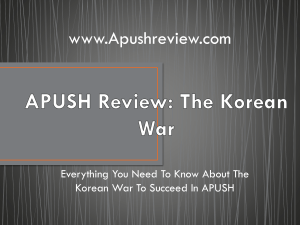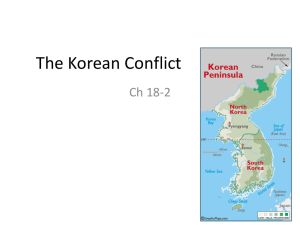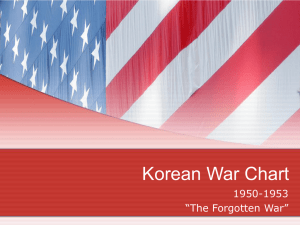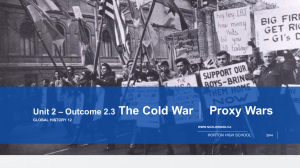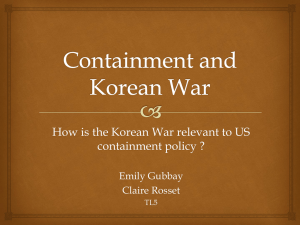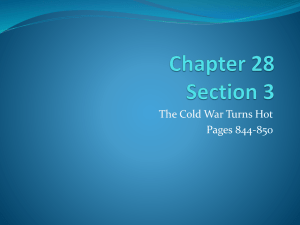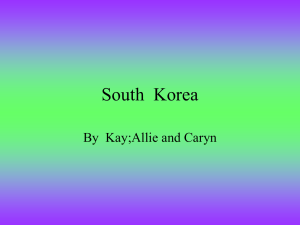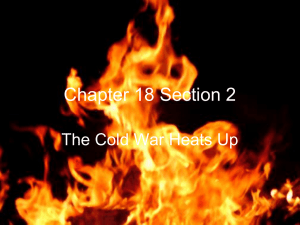The Korean War
advertisement
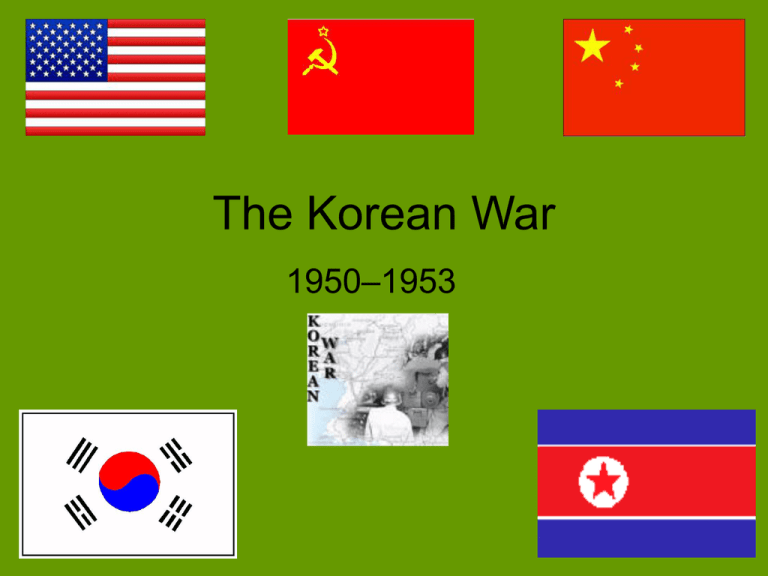
The Korean War
1950–1953
Overview/Background:
The Korean War was the time when the Cold
War became a global conflict. In 1945, Korea
was freed from the Japanese. US troops
stayed in South Korea and Soviet troops
remained in North Korea until 1946. The
country was split in half at the 38th parallel:
North Korea (led by Kim II Sung) was
Communist.
South Korea (led by Syngman Rhee) was
capitalist.
The two countries hated each other. (Grrrr.)
The country was split at the 38th parallel because, when they
were discussing what to do with Korea, the Americans could
only find a small-scale map.
So What Caused The Korean War?
1. President Truman was interested in the Far East:
Hmmm…..I have an interest
in the Far East.
Domino Theory
Europe was not the only place where Communists
were coming to power. In the Far East, too, they
were getting powerful – China turned Communist
in 1949. Truman believed that, if one country fell
to Communism, then others would follow, like a
line of dominoes. He was worried that, if Korea
fell, the Communists would capture Japan.
_______ _______ _______ _______ _______ _______
General MacArthur says...
“Asia is where the communist
conspirators have decided to make
their play for global conquest. If
we lose this war, the fall of Europe
is inevitable. There is no choice
but victory.”
– The US General MacArthur, speaking
in 1950.
Question: Why does General MacArthur think Korea is so important
for the Americans?
Undermine Communism
In April 1950, the American National Security Council issued
a report (NSC 68) recommending that America abandon
'containment' and start 'rolling back' Communism.
Cold War
Truman realized the USA was in a competition for world
domination with the USSR. By supporting South Korea, America
was able to fight Communism without directly attacking Russia.
2. Stalin was also involved in the Far East:
Hmmm..I too
have an interest
in the Far East.
Kim II Sung Gets Support
In 1949, he persuaded Stalin that he
could conquer South Korea. Stalin
did not think that America would dare
to get involved, so he gave his
agreement. Stalin saw a chance to
continue the cold war and discomfort
America, but ‘at arm’s length’ –
without directly confronting the
Americans. Kim II Sung also went to
see Mao Zedong, the leader of
China, to get his agreement.
Syngman Rhee Has A Big Mouth
3. In 1950, Syngman Rhee boasted that he was going to
attack North Korea. It was a good enough excuse – on June
25, 1950 the North Koreans invaded South Korea.
Chairman Syngman Rhee addresses
the National Assembly in 1948.
…and so began the Korean War.
The Events Of The War
June, 1950 – North Korea Invades South
Korea; Truman Commits US Forces.
• The North Koreans attacked.
They were very successful. The
North Korean People's Army
(NKPA) easily defeated the
Republic of Korea's army (the
ROKs)
• They captured most of South
Korea, including the capital of
Seoul.
• The Americans were alarmed
and they persuaded the United
Nations to support South Korea.
Out of the 300,000 UN troops,
260,000 were Americans.
September 15, 1950 – UN Makes
Daring Landing At Inchon
• The American army, led by General
MacArthur, went to Korea. It landed at
Pusan, and made an amphibious landing at
Inchon (near Seoul).
• It drove back the North Koreans and
recaptured South Korea. 125,000 NKPA
prisoners were taken.
October 1, 1950 – South Korean Troops
Cross At The 38th Parallel
• South Korean troops
cross the 38th Parallel
and enter North Korea.
Task: Evaluate the UN decision to
cross into North Korea after
successfully recapturing South
Korea. List the potential positives
and negatives of this action?
Ultimate Goal of this action: to unify Korea under a non-communist government.
Map Interpretation
Based on this map,
why do you think
President Truman
warned MacArthur
to keep the UN
forces at least 40
miles from the
Yalu River?
Yalu River
October 26, 1950 – UN Forces Reach
Yalu River
• North Korea’s capital, Pyongyang, fell to UN troops on
October 20th.
• By October 26th, the first UN troops had reached the Yalu
River. – the border between China and North Korea.
North Korean tank burning in
Pyongyang, October 19, 1950.
November 1950, Massive Chinese
Attack Across The Yalu River
• Now the Chinese were alarmed.
• 200,000 Chinese troops ('People's
Volunteers') attacked MacArthur. They
had modern weapons supplied by
Russia, and a fanatical hatred of the
Americans.
• In December, half a million more
Chinese troops entered the war.
• They drove the Americans back. They
recaptured North Korea, and advanced
into South Korea.
The Chinese troops were a unique enemy, without any
of the characteristics of a traditional American or
European army. There were no officer corps or ranks in
this "people's army." The soldiers addressed their
commanders as "Comrade Platoon Leader" or
"Comrade Company Commander" and were informed
in great detail of their tactical and strategic missions.
February – March 1951: Stalemate
• The Americans landed more
troops. They used bombers.
The Chinese admitted to losing
390,000 men dead - UN
sources put the figure at up a
million Chinese and half a
million North Koreans dead.
• The Americans drove the
Chinese back, but lost 54,000
American soldiers doing so.
• MacArthur reached the 38th
parallel in March 1951.
Approximately 90% of the soldiers fighting in Korea
suffered from frostbite. In fact, much of the war was
fought in extreme cold as Siberian winds whipped across
the Asian peninsula.
March 1951 - President Harry
Truman vs. General Douglas MacArthur
• MacArthur declares "There is no substitute for victory." He
wants to push further. He claimed that the only way to
bring about victory was by taking the war to China.
• In a message to House Republican leader, MacArthur
expressed his frustration with the limited war the U.S. was
fighting against communists. He publicly criticized
Truman’s decisions.
Truman vs. MacArthur Continued
After months of heavy fighting, the center of the conflict was returned
to the 38th parallel, where it remained for the rest of the war.
MacArthur, however, wished to mount another invasion of North
Korea. MacArthur also pressed for permission to bomb Chinese bases
in Manchuria. Truman refused such permission.
When MacArthur persisted in publicly criticizing U.S. policy, Truman, on
the recommendation of the Joint Chiefs of Staff, removed him from
command on April 11, 1951and installed Gen. Matthew B. Ridgeway
as commander in chief. Gen. James Van Fleet then took command of
the 8th Army. Ridgeway began (July 10, 1951) truce negotiations with
the North Koreans and Chinese, while small unit actions, bitter but
indecisive, continued. General Van Fleet was denied permission to go
on the offensive and end the “meat grinder” war.
Who Was Right? – You Decide
Should President Truman have relieved General MacArthur? Who
better understood the situation? Would MacArthur's policies
have ended the war in Korea sooner, or would they have risked
World War III?
Do you think President Truman was right or wrong in dismissing
Gen. MacArthur? Explain your answer.
"We've been using more of a roundish one"
President Harry Truman relieved General Douglas
MacArthur of his Far Eastern command for publicly
undercutting the president's Korean War policies,
and the general returned to Washington, where he
and Defense Secretary George Marshall provided
conflicting testimonies to congressional committees.
MacArthur continued to propose more aggressive
tactics against communist China. Marshall argued
that MacArthur's tactics would draw the United
States into a third world war.
July, 1951
Peace talks begin as both sides continue fighting.
July 27, 1953 – Truce Ends Korean
Fighting; 38th Parallel Is Truce Line
• In July 1953 an armistice, or truce, was agreed upon.
• Korea was to remain divided at the 38th parallel.
• Tension still existed on either side of the demilitarized
zone (DMZ), a neutral area in which no warfare could be
waged.
Results of the Korean War
• It cost the United States 54,000 dead and 103,000 wounded.
• Total UN casualties reached about 400,000 dead or wounded.
• South Korea suffered close to a million civilian casualties, with several
million made homeless.
• Nearly 1½ million North Korean and Chinese soldiers were dead or
wounded.
With such high casualties, how could this possibly be nicknamed
“The Forgotten War?”
QUESTIONS AND TASKS
1. Why do you think this conflict has the
nickname “The Forgotten War?”
2. Was the Korean War a success or a
failure for the United States? Explain
your answer.
